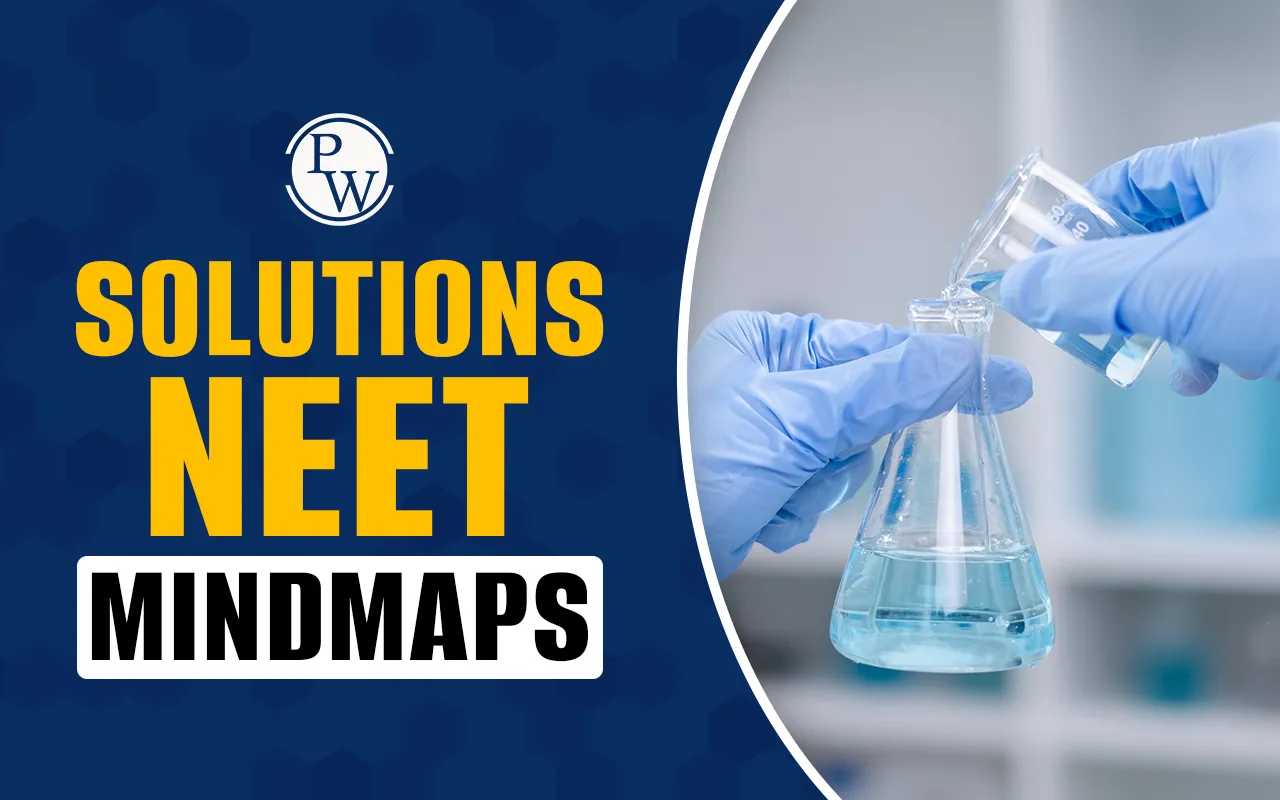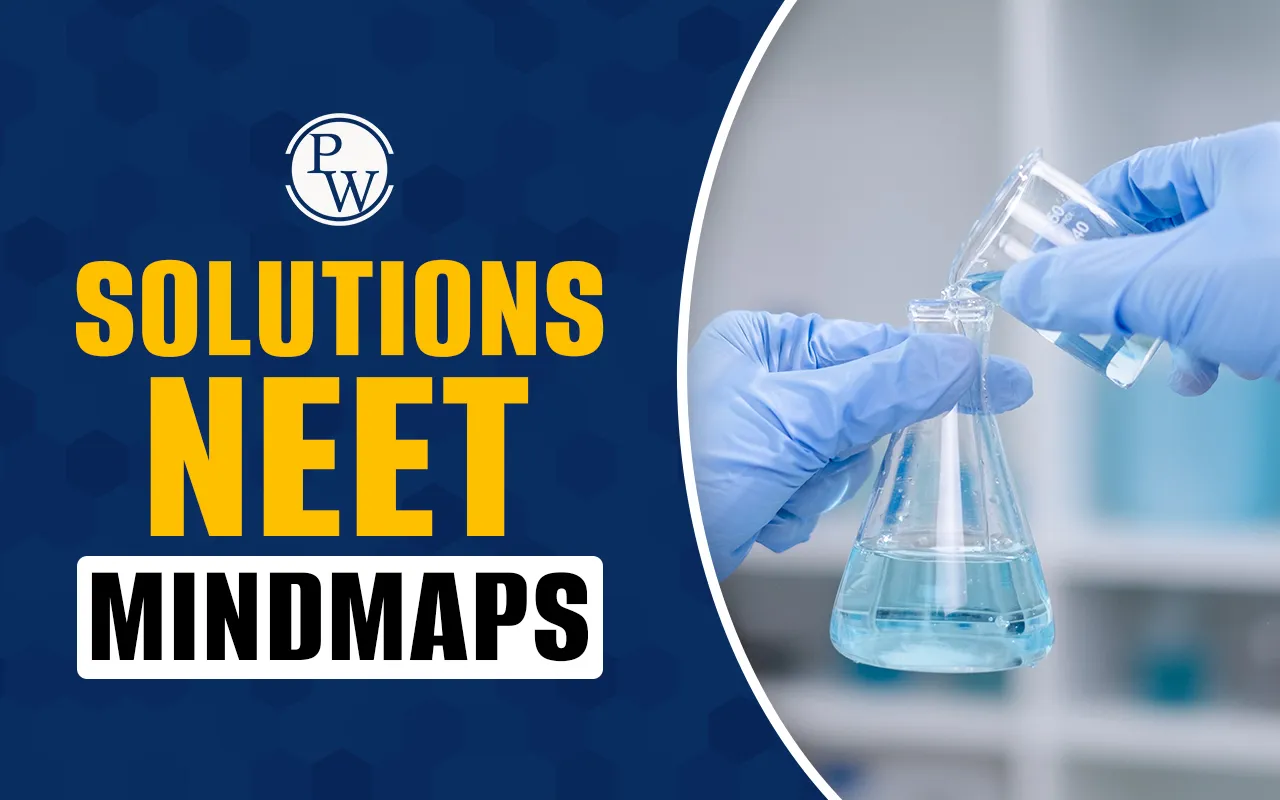

Solutions NEET Mindmap: Solutions chapter is one of the trickiest for NEET aspirants because it combines conceptual understanding with numerical problem-solving. It covers topics like molarity, molality, mole fraction, colligative properties, and Raoult’s law.
This chapter is trickiest as it gets difficult for students converting between different concentration terms or applying colligative property formulas in calculations. Solutions NEET Mindmap by PW present the concepts, formulas, and calculation steps visually, so you can link theory with practice effortlessly.
With the help of the mind map, you can see connections between concentration terms, colligative effects, and Raoult’s law in one glance, which is useful for solving NEET numerical problems under time pressure.
Solutions NEET Mindmap Notes
The mindmap notes cover all essential aspects of the chapter in a structured format:
|
Solutions NEET Mindmap Notes |
|
|
Topic |
Details |
|
Introduction |
Solutions are homogeneous mixtures of solute and solvent; focus on types of solutions, solubility, and concentration. |
|
Concentration Terms |
Molarity (M), Molality (m), Mole Fraction (X), Mass %, ppm, Normality (N). |
|
Solubility |
Maximum amount of solute that dissolves at a given temperature. |
|
Colligative Properties |
Properties dependent on number of solute particles: Vapor pressure lowering, Boiling point elevation, Freezing point depression, Osmotic pressure. |
|
Raoult’s Law |
Partial vapor pressure of solvent in solution is proportional to mole fraction of solvent. |
|
Abnormal Molar Mass and Van’t Hoff Factor |
Accounts for ionization/dissociation in solution. |
|
Applications |
Used in determining molecular masses, depression in freezing point for antifreeze, osmotic pressure in biological systems. |
Solutions NEET Mindmap PDF
Solutions NEET mindmap PDF by PW transforms the entire chapter into a visual reference sheet. Below is the PDF of the mindmap. It allows students to:
-
Trace connections quickly: Visual arrows and clusters show relationships between molarity, molality, mole fraction, and normality.
-
Apply colligative property formulas effectively: ΔTf, ΔTb, osmotic pressure, and Raoult’s law are grouped with clear cues for the van’t Hoff factor.
-
Reinforce formula recall: By seeing all relevant formulas on one page, students can strengthen memory and reduce the chance of mistakes during calculations.
-
Understand problem-solving flow: The PDF shows a logical sequence from identifying the type of concentration term to choosing the correct formula for a NEET problem.
Solutions NEET Mindmap Formulas
Solutions NEET Mindmap Formulas ensure quick calculation and accuracy during NEET numerical problems. The formulas are given here for NEET students:
|
Solutions NEET Mindmap Formulas |
|
|
Concept |
Formula / Relation |
|
Molarity (M) |
M=moles of soluteliters of solutionM = \frac{\text{moles of solute}}{\text{liters of solution}}M=liters of solutionmoles of solute |
|
Molality (m) |
m=moles of solutekg of solventm = \frac{\text{moles of solute}}{\text{kg of solvent}}m=kg of solventmoles of solute |
|
Mole Fraction (X) |
XA=nAnA+nBX_A = \frac{n_A}{n_A + n_B}XA=nA+nBnA |
|
Normality (N) |
N=equivalents of solute/liters of solutionN = \text{equivalents of solute} / \text{liters of solution}N=equivalents of solute/liters of solution |
|
Colligative Properties |
ΔTb = Kb·m·i, ΔTf = Kf·m·i, π = MRT |
|
Raoult’s Law |
P1=X1⋅P10P_1 = X_1 \cdot P_1^0P1=X1⋅P10 |
|
Van’t Hoff Factor |
i=observed colligative property / calculated propertyi = \text{observed colligative property / calculated property}i=observed colligative property / calculated property |
Solutions NEET Mindmap Practice Questions
Practicing questions is essential to prepare well for the Solutions chapter for NEET, as it involves both conceptual understanding and numerical calculations. Using mindmaps will help you visualize the links between formulas, concentration terms, and colligative properties. Below are the Example Practice Questions:
-
Concentration conversions: Convert 0.5 M HCl solution to molality, given the density of the solution.
-
Colligative properties: Calculate the freezing point depression (ΔTf) for a solution containing 2 mol of a non-electrolyte in 500 g of water.
-
Raoult’s law: Determine the vapor pressure of a solution containing 0.2 moles of solute in 1 mole of solvent, given the pure solvent vapor pressure.
-
Van’t Hoff factor (i): Calculate the osmotic pressure of 0.1 M NaCl solution at 298 K, considering complete dissociation.
-
Molecular mass determination: Using boiling point elevation or freezing point depression, calculate the molar mass of an unknown solute.
Topic-Specific Tricks Using Mindmaps
-
Mnemonic for conversions: “Moles in liters = M, Moles in kg = m” – visualize conversions as arrows in the mindmap.
-
Colligative properties linkage: Group ΔTf, ΔTb, and π together in the mindmap to remember formula patterns and units.
-
Electrolyte adjustments: Use color codes or symbols in the mindmap to distinguish when to apply the van’t Hoff factor (i).
-
Problem-solving shortcut: Start each numerical by identifying which term is given (M, m, or X) and trace the arrow in the mindmap to the target formula.
-
Real-life application cues: Connect osmotic pressure with biological examples like dialysis; ΔTf with antifreeze, so formulas are easier to recall.
